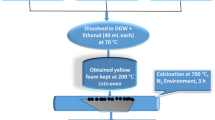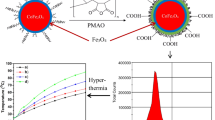Abstract
Powders of maghemite γ-Fe2O3 with an average diameter of 8 nm, γ-Fe2O3/SiO2 composites with an agglomerate diameter of about 50 nm and a size of interspersed γ-Fe2O3 particles of 6 nm, and γ‑Fe2O3/SiO2/aptamer(FAS9) composites were synthesized by chemical deposition. Mössbauer spectra were measured, the static and dynamic magnetic properties of the powders were studied, and the coercive force was determined, which decreases from 14 Oe for γ-Fe2O3 powders to 3 Oe for the γ-Fe2O3/SiO2 composite. It is shown that the particle blocking temperature is close to room temperature. The increment of temperature of the powders was measured in the ferromagnetic resonance mode; the temperature of the Fe2O3/SiO2 composite (ΔT ≈ 16°C) turned out to be higher than that of the pure γ-Fe2O3 powder (ΔT ≈ 10°C). It has been experimentally shown that temperature increment ΔT is proportional to the square of the microwave field amplitude. It has been shown that the composition γ-Fe2O3/SiO2/aptamer FAS9 is able to effectively bind to tumor cells, and FMR hyperthermia leads to a decrease in the viability of tumor cells.






Similar content being viewed by others
REFERENCES
L. M. Rossi, N. J. S. Costa, F. P. Silva, and R. V. Gonçalves, “Magnetic nanocatalysts: Supported metal nanoparticles for catalytic applications,” Nanotechnol. Rev. 2, 597–614 (2013). https://doi.org/10.1515/ntrev-2013-0021
T. D. Dongale, S. S. Khot, A. A. Patil, S. V. Wagh, P. B. Patil, D. P. Dubal, and T. G. Kim, “Bifunctional nanoparticulated nickel ferrite thin films: Resistive memory and aqueous battery applications,” Mater. Des. 201, 109493 (2021). https://doi.org/10.1016/j.matdes.2021.109493
T. V. Drokina, Physical Methods in Medicine (Krasnoyarsk. Gos. Univ., Krasnoyarsk, 2005).
H. Bass, J. L. Moore, and W. T. Coakley, “Lethality in mammalian cells due to hyperthermia under oxic and hypoxic conditions,” Int. J. Radiat. Biol. Relat. Stud. Phys., Chem. Med. 33, 57–67 (1978). https://doi.org/10.1080/09553007714551491
S. Rotundo, D. Brizi, A. Flori, G. Giovannetti, L. Menichetti, and A. Monorchio, “Shaping and focusing magnetic field in the human body: State-of-the art and promising technologies,” Sensors 22, 5132 (2022). https://doi.org/10.3390/s22145132
D. Walton, S. Snape, T. C. Rolph, J. Shaw, and J. Share, “Application of ferrimagnetic resonance heating to palaeointensity determinations,” Phys. Earth Planet. Inter. 94, 183–186 (1996). https://doi.org/10.1016/0031-9201(95)03094-8
J. Lee, Yo. Kim, and S. Kim, “Highly efficient heat-dissipation power driven by ferromagnetic resonance in MFe2O4 (M = Fe, Mn, Ni) ferrite nanoparticles,” Sci. Rep. 12, 5232 (2022). https://doi.org/10.1038/s41598-022-09159-z
M. Peiravi, H. Eslami, M. Ansari, and H. Zare-Zardini, “Magnetic hyperthermia: Potentials and limitations,” J. Indian Chem. Soc. 99, 100269 (2022). https://doi.org/10.1016/j.jics.2021.100269
S. Krupička, Physik der Ferrite und der Verwandten Magnetischen Oxide (Vieweg+Teubner Verlag, Wiesbaden, 1973). https://doi.org/10.1007/978-3-322-83522-2
S. V. Stolyar, O. A. Li, E. D. Nikolaeva, N. M. Boev, A. M. Vorotynov, D. A. Velikanov, R. S. Iskhakov, V. F. Knyazev, Yu. V. Bayukov, O. A. Shokhrina, A. O. Molokeev, M. S. Vasiliev, and A D, “Heating of magnetic powders in the ferromagnetic resonance mode at a frequency of 8.9 GHz,” Phys. Solid State 65, 963 (2023).
S. V. Stolyar, O. A. Li, E. D. Nikolaeva, A. M. Vorotynov, D. A. Velikanov, Yu. V. Knyazev, O. A. Bayukov, R. S. Iskhakov, V. F. P’yankov, and M. N. Volochaev, “An effective method of magnetic hyperthermia based on the ferromagnetic resonance phenomenon,” Phys. Met. Metallogr. 124, 174–180 (2023). https://doi.org/10.1134/s0031918x22601834
B. Herrero De La Parte, I. Rodrigo, J. Gutiérrez-Basoa, S. Iturrizaga Correcher, C. Mar Medina, J. J. Echevarría-Uraga, J. A. Garcia, F. Plazaola, and I. García-Alonso, “Proposal of new safety limits for in vivo experiments of magnetic hyperthermia antitumor therapy,” Cancers 14, 3084 (2022). https://doi.org/10.3390/cancers14133084
J. Lee, B. Kim, Yo. Kim, and S. Kim, “Ultra-high rate of temperature increment from superparamagnetic nanoparticles for highly efficient hyperthermia,” Sci. Rep. 11, 4969 (2021). https://doi.org/10.1038/s41598-021-84424-1
N. Suttie, J. Shaw, and M. J. Hill, “Direct demonstration of microwave demagnetization of a whole rock sample with minimal heating,” Earth Planet. Sci. Lett. 292, 357–362 (2010). https://doi.org/10.1016/j.epsl.2010.02.002
N. Yoshikawa and T. Kato, “Ferromagnetic resonance heating of Fe and Fe3O4 by 5.8 GHz microwave irradiation,” J. Phys. D: Appl. Phys. 43, 425403 (2010). https://doi.org/10.1088/0022-3727/43/42/425403
I. Khmelinskii and V. I. Makarov, “EPR hyperthermia of S. cerevisiae using superparamagnetic Fe3O4 nanoparticles,” J. Therm. Biol. 77, 55–61 (2018). https://doi.org/10.1016/j.jtherbio.2018.08.004
S. Bae, S. W. Lee, and Y. Takemura, “Applications of NiFe2O4 nanoparticles for a hyperthermia agent in biomedicine,” Appl. Phys. Lett. 89, 252503 (2006). https://doi.org/10.1063/1.2420769
K. Ohara, T. Moriwaki, K. Nakazawa, T. Sakamoto, K. Nii, M. Abe, and Y. Ichiyanagi, “Development of biocompatible Ni-ferrite nanoparticles with PEG-coated for magnetic hyperthermia,” AIP Adv. 13 (2023). https://doi.org/10.1063/9.0000477
W. Wu, Z. Wu, T. Yu, C. Jiang, and W. Kim, “Recent progress on magnetic iron oxide nanoparticles: synthesis, surface functional strategies and biomedical applications,” Sci. Technol. Adv. Mater. 16, 023501 (2015). https://doi.org/10.1088/1468-6996/16/2/023501
M. Shen, H. Cai, X. Wang, X. Cao, K. Li, S. H. Wang, R. Guo, L. Zheng, G. Zhang, and X. Shi, “Facile one-pot preparation, surface functionalization, and toxicity assay of APTS-coated iron oxide nanoparticles,” Nanotechnology 23, 105601 (2012). https://doi.org/10.1088/0957-4484/23/10/105601
A. D. Ellington and J. W. Szostak, “In vitro selection of RNA molecules that bind specific ligands,” Nature 346, 818–822 (1990). https://doi.org/10.1038/346818a0
C. Tuerk and L. Gold, “Systematic evolution of ligands by exponential enrichment: RNA ligands to bacteriophage T4 DNA polymerase,” Science 249, 505–510 (1979). https://doi.org/10.1126/science.2200121
P. D. Kim, S. S. Zamay, T. N. Zamay, V. S. Prokopenko, O. S. Kolovskaya, G. S. Zamay, V. Ya. Princ, V. A. Seleznev, A. I. Komonov, E. A. Spivak, R. Yu. Rudenko, A. V. Dubinina, A. V. Komarov, V. V. Denisenko, M. A. Komarova, A. E. Sokolov, A. A. Narodov, V. P. Zjivaev, and A. S. Zamay, “The antitumor effect of magnetic nanodisks and DNA aptamer conjugates,” Dokl. Biochem. Biophys. 466, 66–69 (2016). https://doi.org/10.1134/s1607672916010154
S. V. Stolyar, E. D. Nikolaeva, O. A. Li, D. A. Velikanov, A. M. Vorotynov, V F, V. P. Ladygina, A. S. Sukhachev, D. A. Balaev, and R. S. Iskhakov, “Microwave heating of iron powders in the ferromagnetic resonance mode,” Materialovedenie, No. 9, 10–14 (2023).
O. S. Kolovskaya, T. N. Zamay, A. S. Zamay, Yu. E. Glazyrin, E. A. Spivak, O. A. Zubkova, A. V. Kadkina, E. N. Erkaev, G. S. Zamay, A. G. Savitskaya, L. V. Trufanova, L. L. Petrova, and M. V. Berezovski, “DNA-aptamer/protein interaction as a cause of apoptosis and arrest of proliferation in Ehrlich ascites adenocarcinoma cells,” Biochem. (Moscow), Suppl. Ser. A: Membrane Cell Biol. 8, 60–72 (2013). https://doi.org/10.1134/s1990747813050061
M. Ozaslan, I. D. Karagoz, I. H. Kilic, and M. E. Guldur, “Ehrlich ascites carcinoma,” Afr. J. Biotechnol. 10, 2375–2378 (2011).
S. V. Salikhov, A. G. Savchenko, I. S. Grebennikov, and E. V. Yurtov, “Phase composition and structure of iron oxide nanopowders prepared by chemical means,” Bull. Russ. Acad. Sci.: Phys. 79, 1106–1112 (2015). https://doi.org/10.3103/s1062873815090166
ACKNOWLEDGMENTS
We express our gratitude to the Krasnoyarsk Regional Center for Collective Use of the FRC KSC SB RAS for the equipment provided.
Funding
This work was supported by ongoing institutional funding. No additional grants to carry out or direct this particular research were obtained.
Author information
Authors and Affiliations
Corresponding author
Ethics declarations
The authors of this work declare that they have no conflicts of interest.
Additional information
Publisher’s Note.
Pleiades Publishing remains neutral with regard to jurisdictional claims in published maps and institutional affiliations.
Rights and permissions
About this article
Cite this article
Stolyar, S.V., Li, O.A., Nikolaeva, E.D. et al. Preparation and Properties of Magnetic Composites γ-Fe2O3/SiO2/Aptamer(FAS9) for Magnetic Resonance Hyperthermia. Phys. Metals Metallogr. 124, 1689–1696 (2023). https://doi.org/10.1134/S0031918X23601439
Received:
Revised:
Accepted:
Published:
Issue Date:
DOI: https://doi.org/10.1134/S0031918X23601439




